Swivels are an essential item when making up sea fishing rigs basically designed to eliminate line twist, but they are also used for connecting and attaching lures and other items of tackle too. Few anglers give any thought though, regarding their efficiency in use, but also the different strengths and weaknesses associated with each different swivel design. Here's our pick of the most popular.
Barrel swivels are the cheapest to make and have the lowest retail price, and for that reason alone they are the most popular and best-selling swivel. They were also the very first swivel to be introduced. They get their name from their barrel-shaped central body.
The barrel swivel is manufactured by having the swivel eyes formed by twisting a tag end of wire around the main wire that enters the swivel. Having only one tag end of wire, swaged at the end, to secure it inside the barrel means the swivel is weak in its construction but also has poor rotational efficiency so does not rotate very well when under pressure. This means the Barrel Swivel is the least efficient when it comes to reducing line twist when used on rigs and line.
Also, because of the cheap and simple construction, the Barrel Swivel is the weakest regards overall strength. Under heavy pressure, the single tag end of the wire can simply pull out of the main barrel-shaped housing. Their size is bigger, generally speaking, than other comparable swivels, therefore there is a misconception that these swivels are stronger, but that is not the case. These swivels should never be chosen as the main connector when casting heavy lead weights when surf fishing or uptide casting from boats, or when targeting very big fish, such as conger or tope, that will put a lot of direct pressure through to the rod via the line when a swivel is used as a link in the tackles construction.
These swivels should only be used for basic attachments when targeting smaller fish using lighter hook lengths and in situations where casting pressures are minimal, such as fishing small sub 2oz spinners.
The sizing of Barrel Swivels is also inconsistent as some overseas manufacturers have their own sizings and do not work to a recognised size range.
Typical sizes are a size 6 swivel for attaching hook lengths, and a size 2/0 to 3/0 for direct attachment when fishing heavier tackle. They come in both nickel and a black finish.
Barrel swivels are also made as a 3-way with a third central eye coming out of the side of the main body. These 3-way swivels are useful when you want to have a connector swivel in place on a rig with the middle eye being used for attaching either a hook length when bait fishing. Alternatively, a lead weight attached to the middle eye and a long hook length tied to the lower swivel eye taking an artificial rubber eel, such as when casting for pollack or coalfish off the rocks.
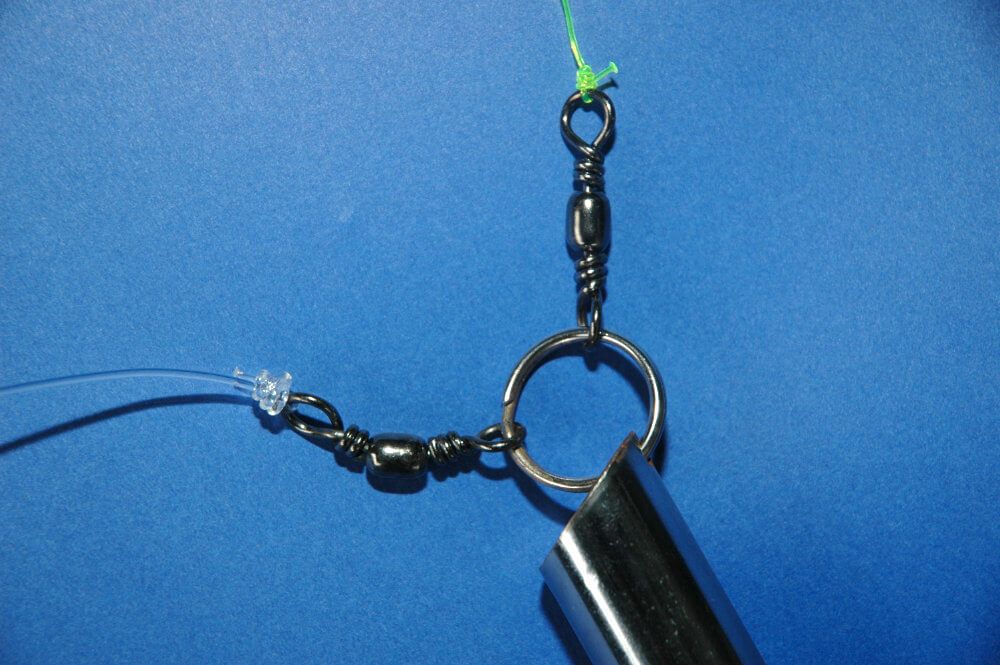
Rolling swivels have a cylindrical central body, and the obvious difference is that if you look at how the swivel eyes are formed, both swaged tag ends that form the eyes enter, and are secure, well inside the ends of the swivels body. This dramatically increases the overall strength of the swivel. It also allows the swivel to be reduced a little in overall size.
The Rolling Swivel is also more efficient at rotation when under heavy pressure helping to reduce line twist and tangles. This increase in quality sees a higher retail cost but is a price worth paying.
The sizing of these swivels are normally more consistent, also the strength ratings are more accurate with a size 6 Rolling Swivel being rated as having a breaking point around 40lbs, and a size 1/0 in the region of 100lbs.
Being stronger and more reliable when it comes to pressured rotation, the Rolling Swivel is a popular and reliable choice both for attaching hook lengths, but also as a main connector swivel between a shock leader and the rig when casting under power to long-range with heavy lead weights.
Again, these swivels are available in a nickel or black finish. The black is preferred as the black naturally blends in better with any surrounding ground the rig is fishing on.
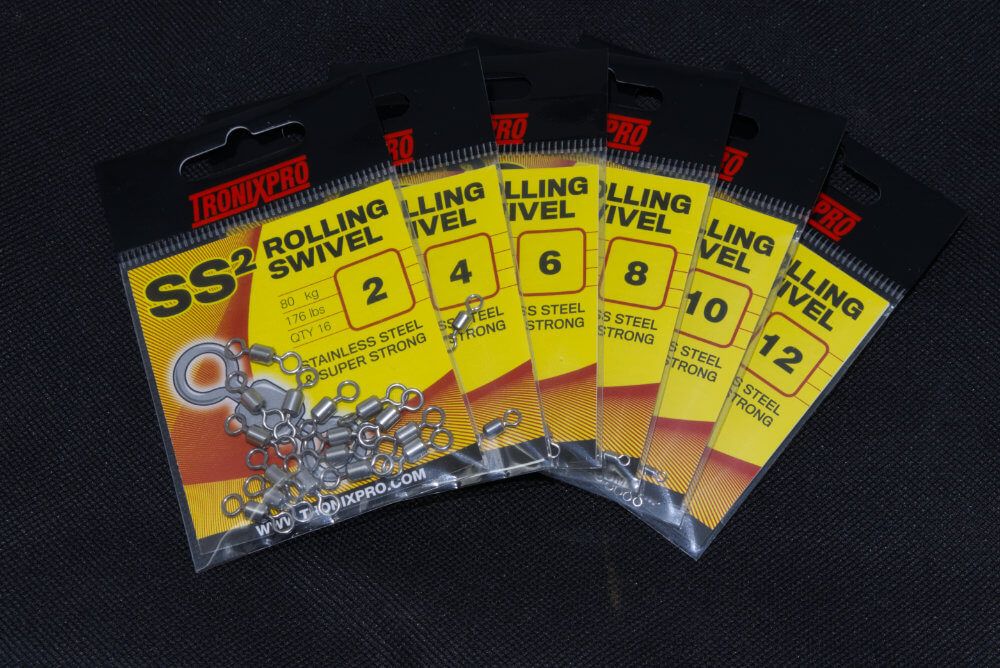
Crane swivels have a rounded central body and as with the Rolling Swivels, both ends of the wire that forms the swivels eyes are centrally and securely fixed in the ends of the swivel body. They are also carefully manufactured to be stronger and more efficient at rotation when under load.
This increase in performance is reflected in the breaking strains for the size of the swivel. A typical breaking point for a size 6 Crane Swivel would be around 100lbs, with a size 1/0 swivel being more towards 200lbs of direct pull pressure before a breakage would occur.
These swivels are chosen by the angler who puts his tackle under extreme pressure when casting to ultra-long-range, and when targeting big hard pulling fish like conger eels and average-sized sharks, also common skate.
Due to their increased performance they are naturally more expensive to buy than the previous Barrel and Rolling swivels. They also come in Black and nickel finishes, but again knowledgeable anglers would choose the black finish as silver-coloured swivels used on heavy hook traces and wire shark traces can reflect light underwater with predators attacking the flash they see and biting the line resulting in loss of tackle and possibly a hooked a fish.
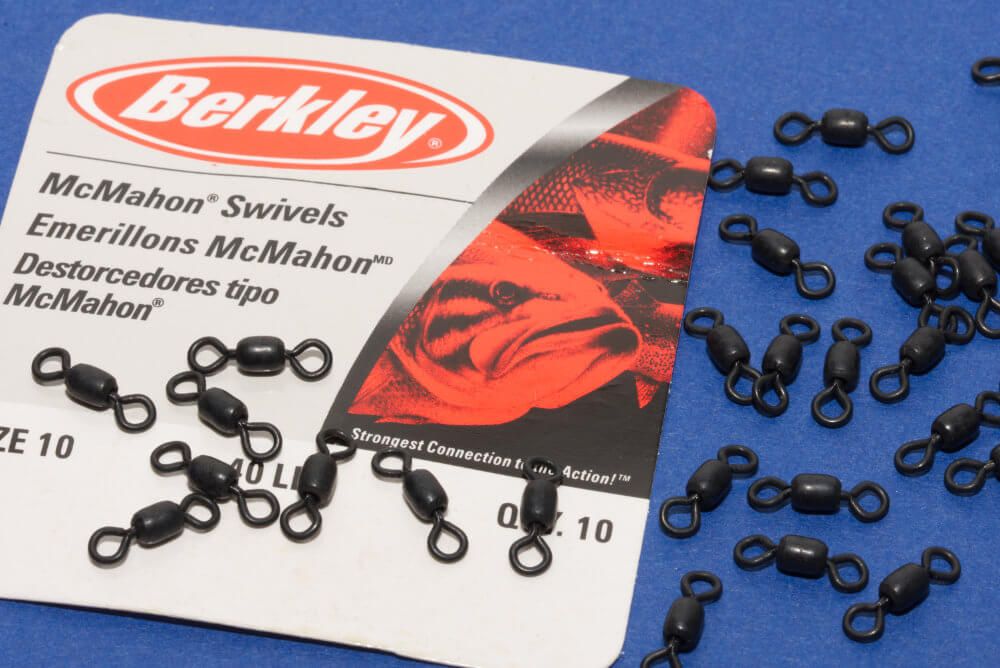
Link swivels can be all the above swivels, Barrel, Rolling and Crane but with a clip link added so you can attach lures and rigs.
Some links are jaw type links which are okay for general light lure work when targeting smaller fish, but under heavy pressure these can open out or break. Another is the American Snap link that features a tag end of wire clipping into a fold of bent metal. These too are weak and prone to opening out under heavy pressure. The best for strength are the links that are formed from heavy wire that is looped over at the tag end with this clipping around the main wire of the link. These are called interlocking links. The wire is tensile, so strong, and needs major pressure just to open it if it is a quality swivel. A Crane Swivel with an interlocking link is the strongest of all the swivel links and the one to use when targeting big fish from both boat and shore.
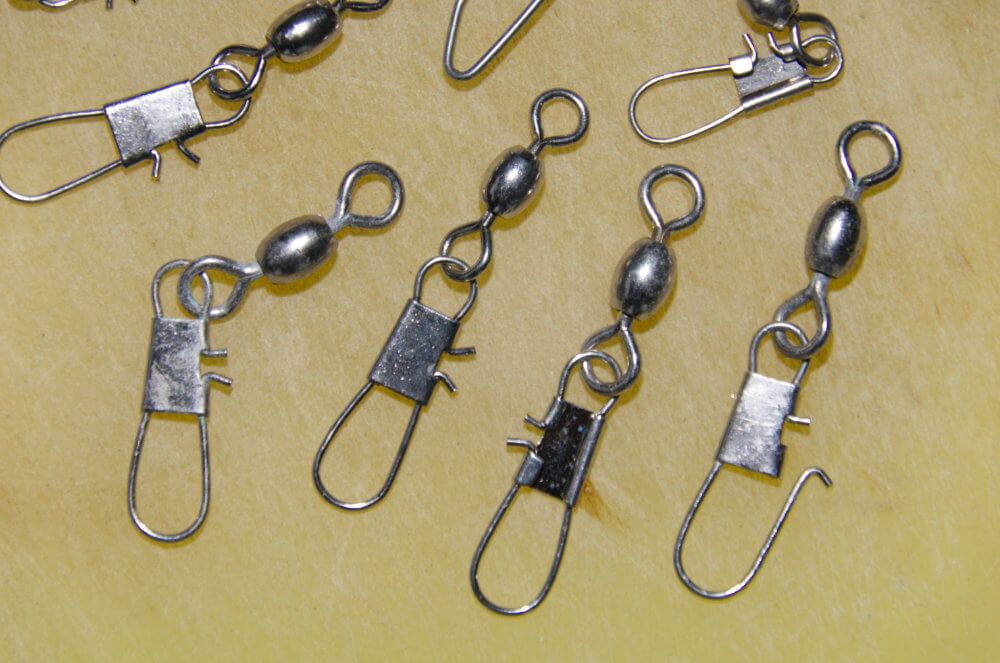
Ball-bearing swivels are the most expensive, but also by far the most efficient when it comes to rotation under maximum pressure. These are the swivels chosen by big game anglers overseas, and those targeting massive wreck conger eels, also big blue, porbeagle and thresher sharks in UK waters.
Their design sees the eyes formed separately with no direct contact with the main body. The bearings are housed in the body and formed with small connector holes that take the round wire eyes. This creates a massively strong construction that can take huge pressure unlikely to be ever exerted by even a heavy big game rod under severe strain.
Rolling and crane swivels offer the UK sea angler as much strength in a swivel as he'll ever really need, so ball-bearing swivels are rarely used in UK sea angling circles.
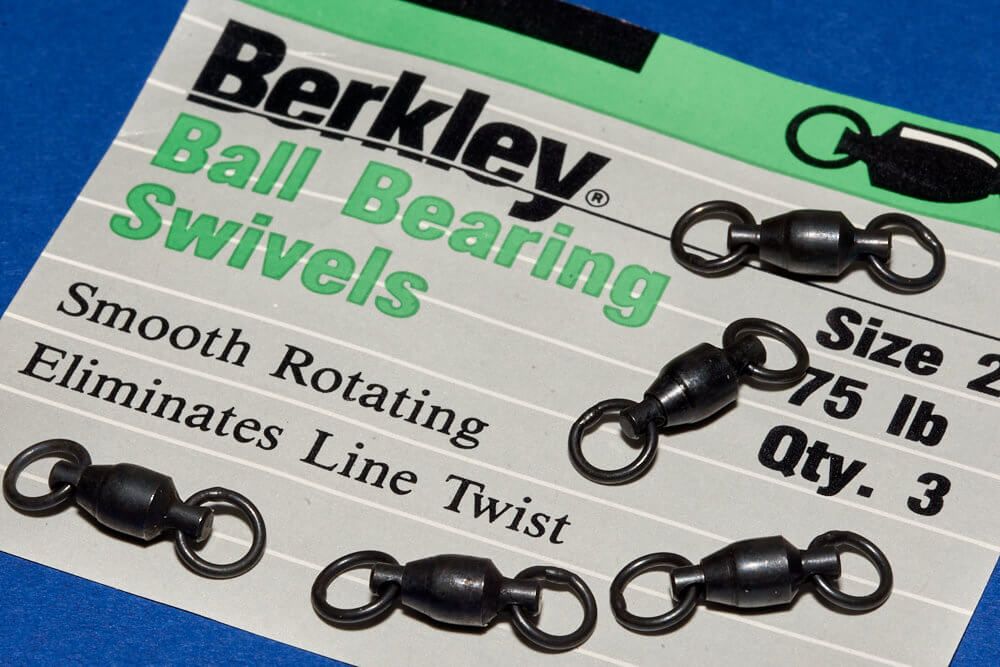
There are many inferior swivels on the market and care needs to be taken when buying swivels that need to be strong and absolutely reliable. It makes sense to go by recommended makes with a proven track record. For general swivels, Berkley, Mustad, Gemini, Tronixpro and others set a consistent standard, which also applies to link swivels.
Sampo, Berkley and Mustad big game swivels are the ones the experienced anglers choose as they have many huge fish, national and international records to their name.
Barrel Swivel
Barrel swivels are the cheapest to make and have the lowest retail price, and for that reason alone they are the most popular and best-selling swivel. They were also the very first swivel to be introduced. They get their name from their barrel-shaped central body.
The barrel swivel is manufactured by having the swivel eyes formed by twisting a tag end of wire around the main wire that enters the swivel. Having only one tag end of wire, swaged at the end, to secure it inside the barrel means the swivel is weak in its construction but also has poor rotational efficiency so does not rotate very well when under pressure. This means the Barrel Swivel is the least efficient when it comes to reducing line twist when used on rigs and line.
Also, because of the cheap and simple construction, the Barrel Swivel is the weakest regards overall strength. Under heavy pressure, the single tag end of the wire can simply pull out of the main barrel-shaped housing. Their size is bigger, generally speaking, than other comparable swivels, therefore there is a misconception that these swivels are stronger, but that is not the case. These swivels should never be chosen as the main connector when casting heavy lead weights when surf fishing or uptide casting from boats, or when targeting very big fish, such as conger or tope, that will put a lot of direct pressure through to the rod via the line when a swivel is used as a link in the tackles construction.
These swivels should only be used for basic attachments when targeting smaller fish using lighter hook lengths and in situations where casting pressures are minimal, such as fishing small sub 2oz spinners.
The sizing of Barrel Swivels is also inconsistent as some overseas manufacturers have their own sizings and do not work to a recognised size range.
Typical sizes are a size 6 swivel for attaching hook lengths, and a size 2/0 to 3/0 for direct attachment when fishing heavier tackle. They come in both nickel and a black finish.
Barrel swivels are also made as a 3-way with a third central eye coming out of the side of the main body. These 3-way swivels are useful when you want to have a connector swivel in place on a rig with the middle eye being used for attaching either a hook length when bait fishing. Alternatively, a lead weight attached to the middle eye and a long hook length tied to the lower swivel eye taking an artificial rubber eel, such as when casting for pollack or coalfish off the rocks.

Rolling Swivels
Rolling swivels have a cylindrical central body, and the obvious difference is that if you look at how the swivel eyes are formed, both swaged tag ends that form the eyes enter, and are secure, well inside the ends of the swivels body. This dramatically increases the overall strength of the swivel. It also allows the swivel to be reduced a little in overall size.
The Rolling Swivel is also more efficient at rotation when under heavy pressure helping to reduce line twist and tangles. This increase in quality sees a higher retail cost but is a price worth paying.
The sizing of these swivels are normally more consistent, also the strength ratings are more accurate with a size 6 Rolling Swivel being rated as having a breaking point around 40lbs, and a size 1/0 in the region of 100lbs.
Being stronger and more reliable when it comes to pressured rotation, the Rolling Swivel is a popular and reliable choice both for attaching hook lengths, but also as a main connector swivel between a shock leader and the rig when casting under power to long-range with heavy lead weights.
Again, these swivels are available in a nickel or black finish. The black is preferred as the black naturally blends in better with any surrounding ground the rig is fishing on.

Crane Swivels
Crane swivels have a rounded central body and as with the Rolling Swivels, both ends of the wire that forms the swivels eyes are centrally and securely fixed in the ends of the swivel body. They are also carefully manufactured to be stronger and more efficient at rotation when under load.
This increase in performance is reflected in the breaking strains for the size of the swivel. A typical breaking point for a size 6 Crane Swivel would be around 100lbs, with a size 1/0 swivel being more towards 200lbs of direct pull pressure before a breakage would occur.
These swivels are chosen by the angler who puts his tackle under extreme pressure when casting to ultra-long-range, and when targeting big hard pulling fish like conger eels and average-sized sharks, also common skate.
Due to their increased performance they are naturally more expensive to buy than the previous Barrel and Rolling swivels. They also come in Black and nickel finishes, but again knowledgeable anglers would choose the black finish as silver-coloured swivels used on heavy hook traces and wire shark traces can reflect light underwater with predators attacking the flash they see and biting the line resulting in loss of tackle and possibly a hooked a fish.

Link Swivels
Link swivels can be all the above swivels, Barrel, Rolling and Crane but with a clip link added so you can attach lures and rigs.
Some links are jaw type links which are okay for general light lure work when targeting smaller fish, but under heavy pressure these can open out or break. Another is the American Snap link that features a tag end of wire clipping into a fold of bent metal. These too are weak and prone to opening out under heavy pressure. The best for strength are the links that are formed from heavy wire that is looped over at the tag end with this clipping around the main wire of the link. These are called interlocking links. The wire is tensile, so strong, and needs major pressure just to open it if it is a quality swivel. A Crane Swivel with an interlocking link is the strongest of all the swivel links and the one to use when targeting big fish from both boat and shore.

Ball Bearing Swivels
Ball-bearing swivels are the most expensive, but also by far the most efficient when it comes to rotation under maximum pressure. These are the swivels chosen by big game anglers overseas, and those targeting massive wreck conger eels, also big blue, porbeagle and thresher sharks in UK waters.
Their design sees the eyes formed separately with no direct contact with the main body. The bearings are housed in the body and formed with small connector holes that take the round wire eyes. This creates a massively strong construction that can take huge pressure unlikely to be ever exerted by even a heavy big game rod under severe strain.
Rolling and crane swivels offer the UK sea angler as much strength in a swivel as he'll ever really need, so ball-bearing swivels are rarely used in UK sea angling circles.

Buying Swivels
There are many inferior swivels on the market and care needs to be taken when buying swivels that need to be strong and absolutely reliable. It makes sense to go by recommended makes with a proven track record. For general swivels, Berkley, Mustad, Gemini, Tronixpro and others set a consistent standard, which also applies to link swivels.
Sampo, Berkley and Mustad big game swivels are the ones the experienced anglers choose as they have many huge fish, national and international records to their name.

